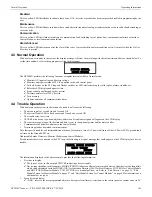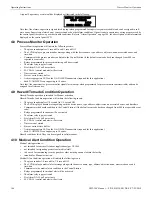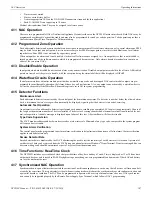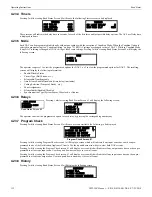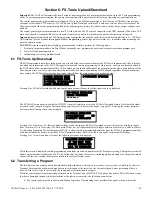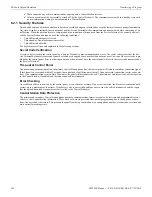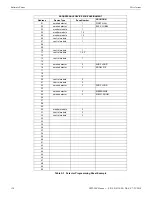
NFW-50X Manual —
P/N LS10129-001NF-E:C 7/25/2018
117
Section 5: Central Station Communications - POTS Transmission
The control panel transmits zone and system status reports to Central Stations via the public switched telephone network. Two super-
vised telephone line connections are made to interface the control panel to the telephone lines. Two optional 7 foot telephone cords are
available for this purpose and can be purchased separately.
The control panel supervises both telephone lines for proper voltage. A delay of two minutes will occur before a fault in either phone line
connection is reported as a trouble. When a fault is detected, an audible trouble signal will sound, the yellow trouble LED will blink, the
LCD display will indicate the phone line trouble and the trouble condition will be reported to the Central Station over the remaining
operational phone line.
The control panel comes with line seizure capability provided for both the primary and secondary telephone line interfaces. Any time
that the control panel needs to make a call to a Central Station, line seizure will disconnect any local premises phones sharing the same
telephone line.
All transmissions to the Central Stations will be sent over the primary phone line. In the event of noisy phone lines, transmissions will be
sent over the backup secondary phone line.
Two phone numbers must be programmed, the primary Central Station phone number and the secondary Central Station phone number.
All system reports will be transmitted to the primary Central Station phone number. Reports will automatically be sent to the secondary
Central Station phone number if attempts to transmits to the primary Central Station phone number are unsuccessful. If 10 total attempts
to communicate are unsuccessful, a Communicator Failure report will be displayed.
The NFW-50X meets NFPA 72 National Fire Code reporting requirements for: (a) the type of signal, (b) condition and (c) location of the
reporting premises. The general priority reporting structure is:
1.
Zone Alarms and Restores
2.
Zone Troubles and Restores
3.
System Troubles and Restores
4.
24-hour Test
The minimum wire gauge allowed is 26 AWG.
5.1 Transmittal Priorities
The integral communicator transmits highest priority events first. Events, in terms of priority, are listed below in descending order:
1.
Alarms (highest priority level)
Pull stations
Waterflow
Smoke detector
Other fire alarm types
CO alarm
2.
Supervisory Zone
3.
System Troubles
Zone disabled
Fire drill
AC fail (after delay)
Zonal faults
Earth fault
Low battery
Telephone line fault
Notification Appliance Circuits fault
Communication trouble
Annunciator trouble
System off normal
4.
Restoral Reports
Zone alarm
Supervisory
Zone(s) enabled
Fire drill
AC
Zone fault
Earth
Battery
Telephone line
Notification Appliance Circuits
Communication
Annunciator trouble
System off normal
5.
24 Hour Test (lowest priority)

